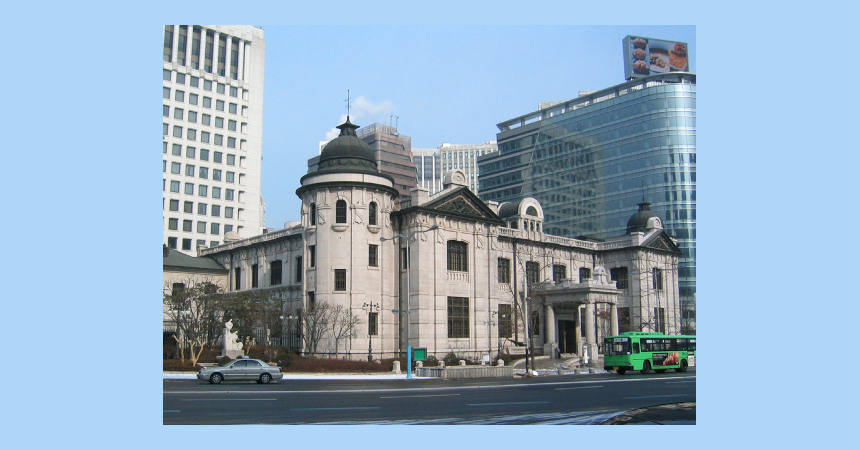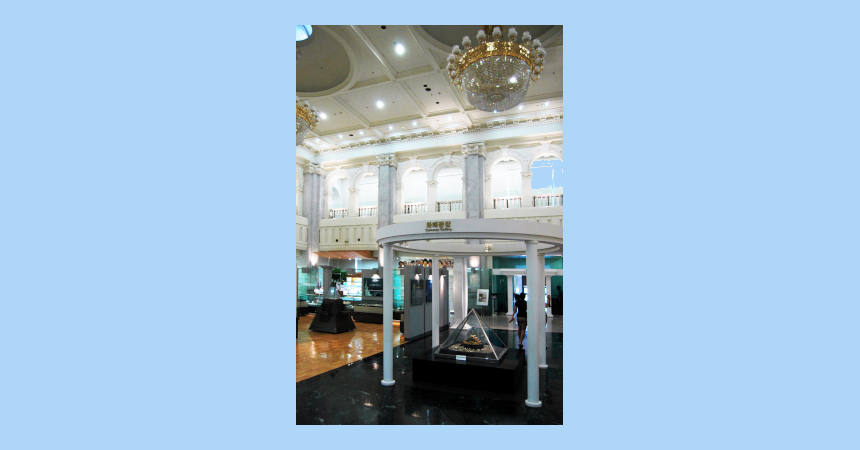Bank of Korea Museum
Wenn es kein Logo gibt, wird diese Spalte einfach leer gelassen. Das Bild oben bitte löschen.
(Dieser Text wird nicht dargestellt.)
110 Namdaemunno 3-ga, Jun-gu
Seoul, Republic of Korea
Tel: +82 (0)2 1330
Opened in 2001 to commemorate the Bank of Korea’s golden anniversary, the Museum is housed in what was once the Bank of Korea’s head office and is a designated historical structure that was built in 1912. The Museum’s exhibition is spread over two floors and a mezzanine. The text of the exhibits is primarily in Korean although some English is used. Brochures are available in Korean, English, Japanese, and Chinese.
1st-Floor Exhibits
There are five major exhibits in addition to a library and book shop on the 1st (ground) floor. In the “About the Bank of Korea” exhibit, visitors learn about the Bank of Korea, established in 1950, what happens in the Bank, and how the Bank is organized and managed. The original zinc plates used for printing the first banknotes issued by the Bank of Korea are on display. The Currency Exhibition Hall has on display Korean currencies from its various periods in chronological order where Hangul wasn’t used on Korean banknotes until 1962, plus historical currencies from around the world. Even banknotes from North Korea are shown with their propaganda themes.
The “Life of Currency” exhibit explains the manufacturing, circulating, and redemption process for damaged currency. When Korean banknotes are unfit, they’re shredded up and turned into sound insulation for cars. The security measures on banknotes and how counterfeits are identified is explained. Interactive computer screens allow visitors to examine various security features of Korea’s 10,000-won banknote.
As the nation’s central bank, the “Money and the National Economy” exhibit emphasizes the importance of price stabilization and monetary and credit policies using video clips, models, and computer games.
Mezzanine
One area of the mezzanine represents donated currencies from a variety of people since its opening. An exhibition promotes these donations, paying tribute to the donors. The “Currency Handling Equipment” exhibit showcases equipment and machines that the Bank uses to handle money and eventually to shred unusable banknotes. This includes machines for identification, counting, bundling, packaging in vinyl for storage and sorting of coins and banknotes.
2nd-Floor Exhibits
The top floor is perhaps the Museum’s most popular area. The “Replica Vault” simulates a real vault filed with stacks of banknotes on pallets behind a security glass. Currencies from 170 nations in the “Currencies From Around the World” exhibit illustrate banknotes having the same design, different materials used for coins and banknotes, unusual denominations of banknotes and coins, sizes of banknotes that vary with denomination or same size for all denominations, and banknotes with different themes. There are slide out panels with banknotes from these countries so visitors can see both sides of the banknotes, and scenes of the country appear on an adjoining video screen.
For a small fee, visitors can have their face printed on a 50,000-won banknote. There is also an impressive touch-screen simulated waterfall of money where visitors can touch any given banknote and learn about both it and its country of origin.
Several activities that appeal to children and adults are in the “Play and Learn with Money” exhibit area. A two-player game requires matching the currency to the country. Another tests if you can match currency symbols, such as ¥, with their correct countries. Visitors can also make their own coin using a replica coin press.
This text was written by Howard M. Berlin and first published in his book Numismatourist in 2014.
You can order his numismatic guidebook at Amazon.








